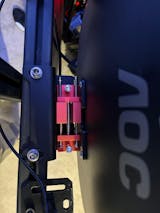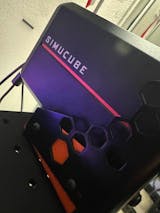
USB vs. Bluetooth Sim Racing Wheels: Which Should You Choose?
The connection between your sim racing wheel and gaming system affects everything from lap times to long-term satisfaction with your setup. Yet most buyers focus entirely on wheel specs while overlooking this critical decision.
Whether you're considering a complete AS13 6DOF system or building around an SP turnkey rig, choosing between USB and Bluetooth connectivity will impact your racing experience for years. The wrong choice can cause frustration that undermines even the most expensive hardware.
As racing simulators become more complex, integrating motion platforms, tactile feedback systems, dashboards, and VR headsets, your wheel’s connection type plays a bigger role in overall system harmony.
Here’s what years of building simulators and real customer feedback reveal about choosing the right connection.
The Latency Reality Most Reviews Ignore
Every sim racing forum throws latency numbers around. It’s true: USB wheels respond faster than Bluetooth because of the direct data transfer. But those numbers need context.
When you’re running hotlaps at Laguna Seca trying to nail the apex through the Corkscrew, even a 10 to 15 millisecond delay from Bluetooth can throw off your rhythm. Your brain expects immediate feedback, and any lag creates a disconnect.
But if you're just cruising in Forza Horizon with friends, the delay is negligible. For casual racers, context often matters more than raw specs.
Where Bluetooth Actually Makes Sense
USB loyalists shouldn’t dismiss Bluetooth outright. There are situations where a bluetooth steering wheel makes perfect sense for sim racing.
One customer outfitted an SP cockpit in his apartment's shared living room. Wires running across the floor weren’t an option. A Bluetooth wheel gave him the freedom to race without turning their space into a race shop.
Bluetooth is also great for multi-platform users. Switching from PC to PlayStation or Xbox becomes seamless, without crawling behind the rig to swap cables.
Battery anxiety? Mostly outdated. Today’s Bluetooth wheels last 20 or more hours on a single charge. Unless you’re running an endurance race into the night, power won’t be a problem.
The USB Advantage: When Wired Just Works Better
For users running 6DOF motion platforms, USB is the go-to. Systems that move your body based on game physics demand tight feedback loops. Any delay isn’t just annoying, it can cause nausea.
Racers using triple screens or VR also benefit from USB stability. In dense wireless environments, Bluetooth faces interference from routers, headsets, controllers, and more.
Professional sim drivers training for real-world events choose USB for consistency. These setups are focused on shaving tenths off laps, not convenience.
Force Feedback: Why USB Hits Harder
USB wheels draw unlimited power directly from your system. Bluetooth wheels are battery-limited by design.
That means USB offers stronger and more consistent force feedback. From initial tire squeals to the fine texture of curbs at Eau Rouge, USB delivers the detail.
"I'm loving the MOZA R5 bundle. Super responsive, solid force feedback, and feels premium overall." — Verified Apevie Customer
Bluetooth wheels may feel fine at first, but after a few hours, feedback can fade. This is especially true for any bluetooth steering wheel that isn’t optimized for high-end force feedback. Some drivers adapt without noticing until they switch back to USB and realize what they were missing.
The Cost of Reliability
USB wheel setups typically range from $800 to $2,500, depending on performance. Bluetooth wheels cost similarly upfront, but USB has a longer lifespan. There are no batteries to replace and fewer wireless components to fail.
For buyers investing in AS2 5DOF or high-end simulators, a USB wheel becomes a long-term asset. As one customer put it:
"Fantastic product. Made heavy-duty. Great service and support. Buy it. Don’t hesitate!"
Installation: Not As Complicated As You Think
Cable management can seem intimidating, but most aluminum cockpits come with built-in cable channels. Run your USB once during setup, secure it, and forget it. The result is clean, professional, and permanent.
Bluetooth is plug-and-play. Pair once and race. But wireless issues like pairing failures or dropped signals often surface mid-race.
"Shipping was fast. Quality is amazing."
"I love my Moza R12, CS V2P Wheel, and Table Mount Bracket. Everything came as advertised in three days."
Motion Platform Considerations
Motion systems such as 6DOF platforms require ultra-low latency. Even a small delay between steering input and physical motion can break immersion or cause motion sickness.
Bluetooth’s variable latency introduces risk. USB ensures tight timing and consistent input, which is essential for realism and comfort.
Wireless Interference: A Real-World Concern
Bluetooth operates on the crowded 2.4GHz frequency. That’s the same range used by WiFi, gaming controllers, and wireless headsets.
The result? Signal drops, latency spikes, and pairing issues. Professional sim installers often recommend USB for this reason alone because it eliminates these variables completely.
Quick Comparison: USB vs. Bluetooth Wheels
For those comparing both options at a glance, here’s how USB and Bluetooth sim racing wheels stack up in real-world use.
|
Feature |
USB |
Bluetooth |
|
Latency |
Low (1–5 ms) |
Moderate (10–25 ms) |
|
Force Feedback |
Strong, consistent |
May weaken as battery drains |
|
Installation |
More involved (cable routing) |
Easy setup, plug and play |
|
Reliability |
Very high, consistent |
Occasional dropouts and interference |
|
Best For |
Motion platforms, VR, pro racers |
Casual gaming, shared or mobile setups |
|
Battery Dependency |
No (powered directly) |
Yes (battery life affects performance) |
|
Platform Flexibility |
PC-focused, wired |
Easily switches between consoles and PC |
Summary:
If you value performance, consistency, and motion platform compatibility, USB remains the best choice. But a bluetooth steering wheel can be a smart option for casual racers or those needing a cleaner setup in a shared space. Consider your rig goals, space, and racing style before choosing.
Making the Right Choice for Your Setup
If you:
- Race daily or competitively
- Use VR or motion platforms
- Have a dedicated sim room
Choose USB. Performance and reliability pay off long term.
If you:
- Race casually on weekends
- Share space or change setups frequently
- Prioritize convenience over consistency
Bluetooth might work just fine.
Final Verdict
Both technologies have a place. After working with racers at all levels, the trend is clear.
- Serious setups benefit from USB reliability.
- Casual or flexible setups enjoy Bluetooth convenience.
It’s not about specs. It’s about how, where, and why you race.
Need Help Choosing?
Apevie Simulator has been building custom racing rigs since 2019. Based in California, we offer everything from entry-level SP cockpits to full professional-grade 6DOF simulators, with nationwide installation.
Not sure what fits your setup best? Contact us today and we’ll help you build a system that matches your goals, space, and driving style.


